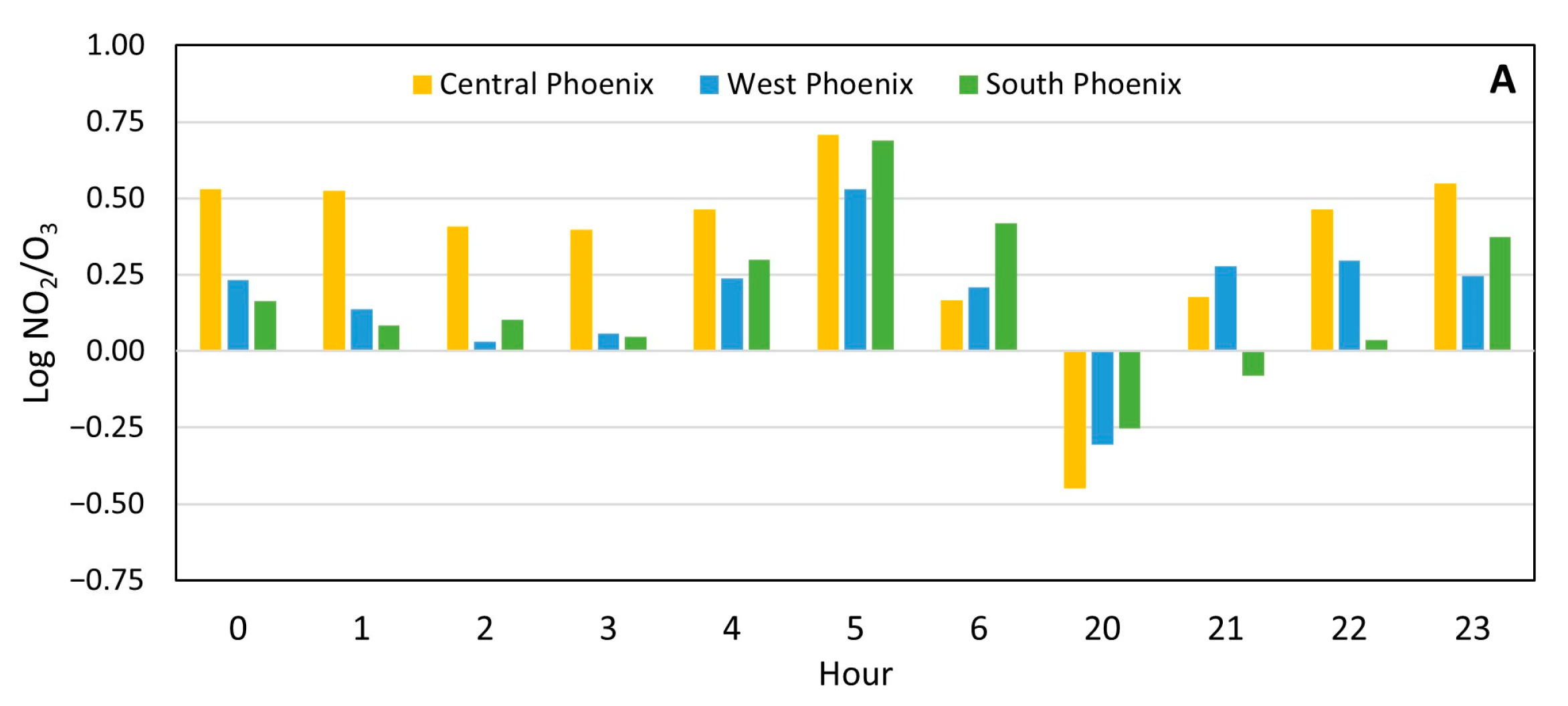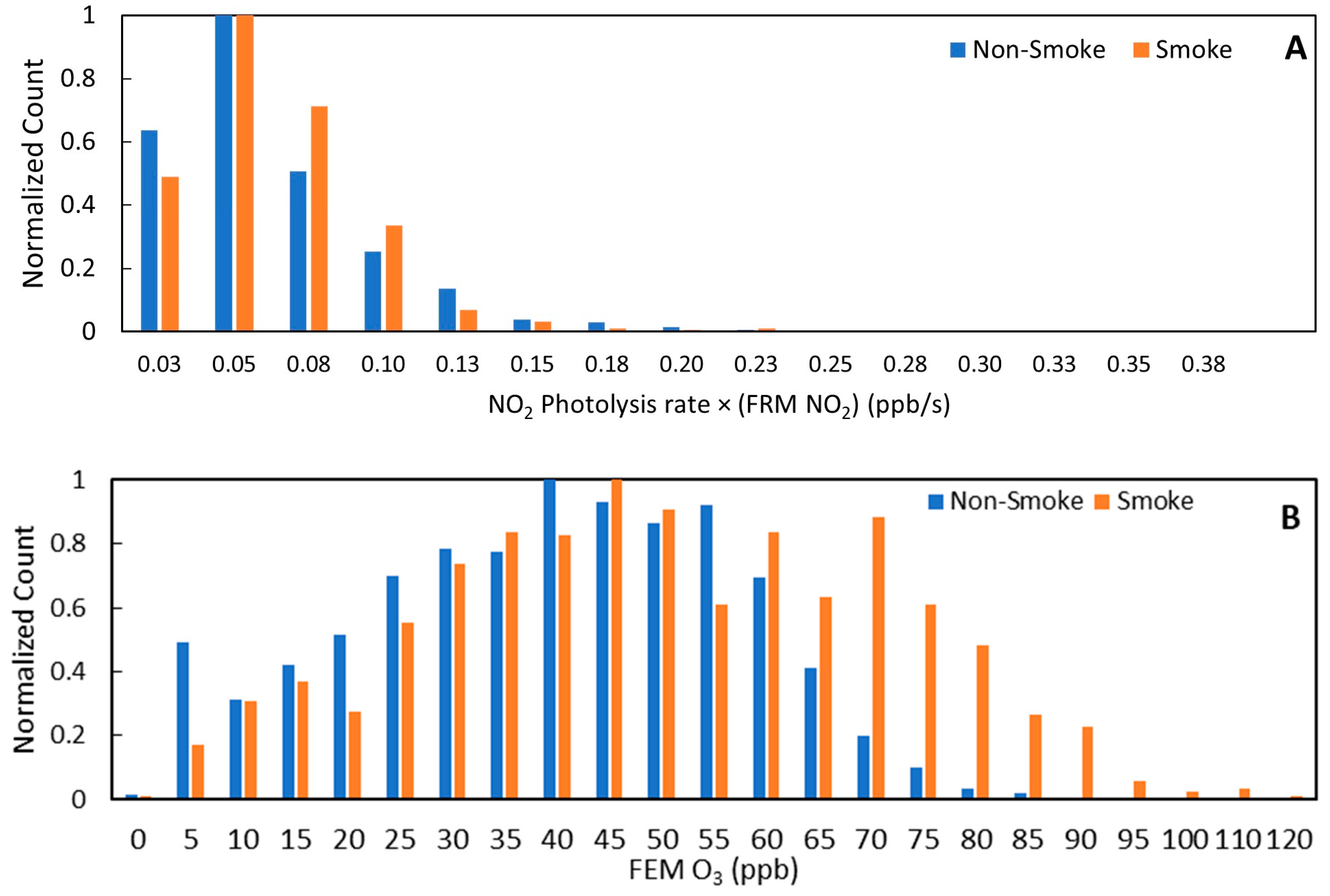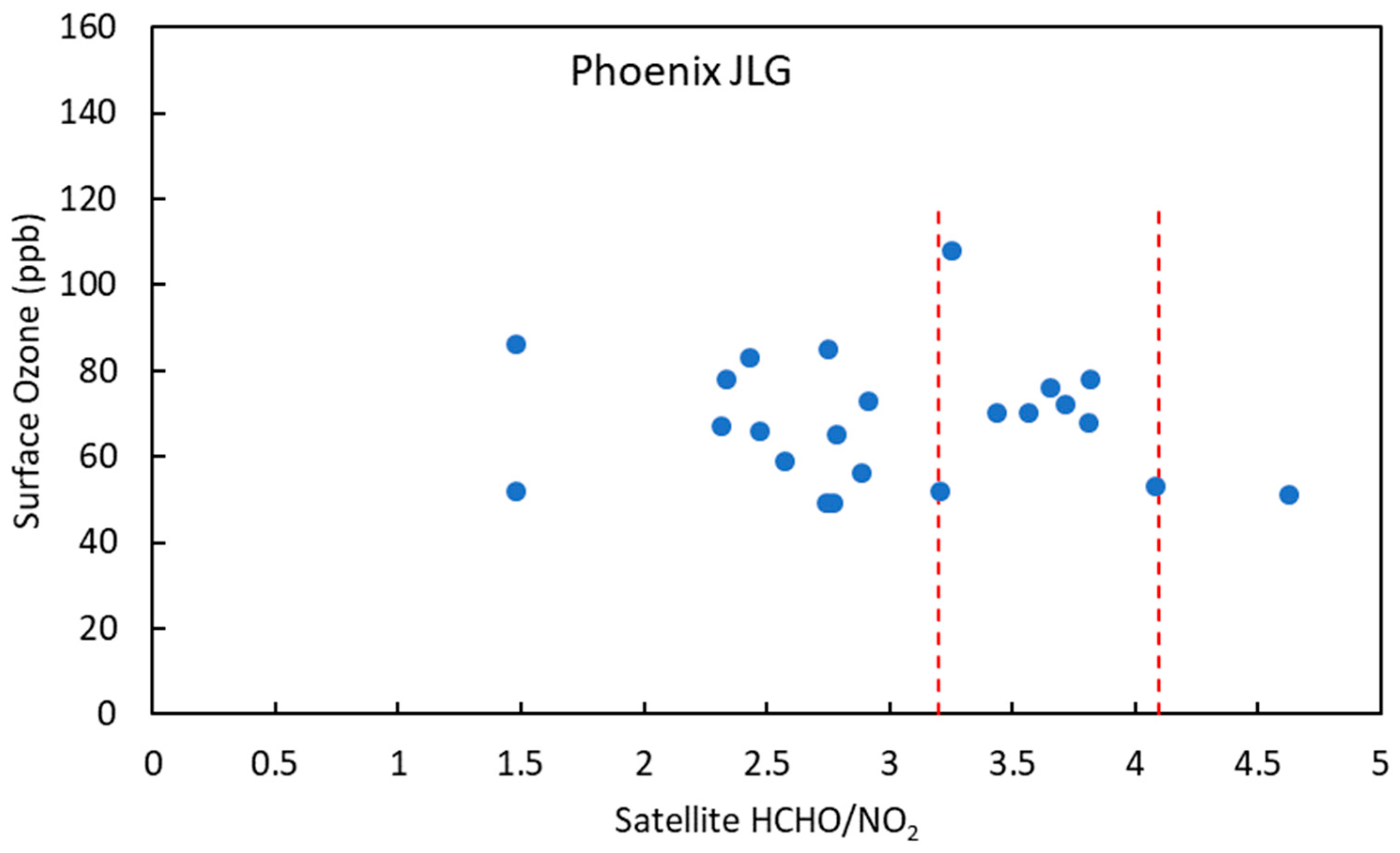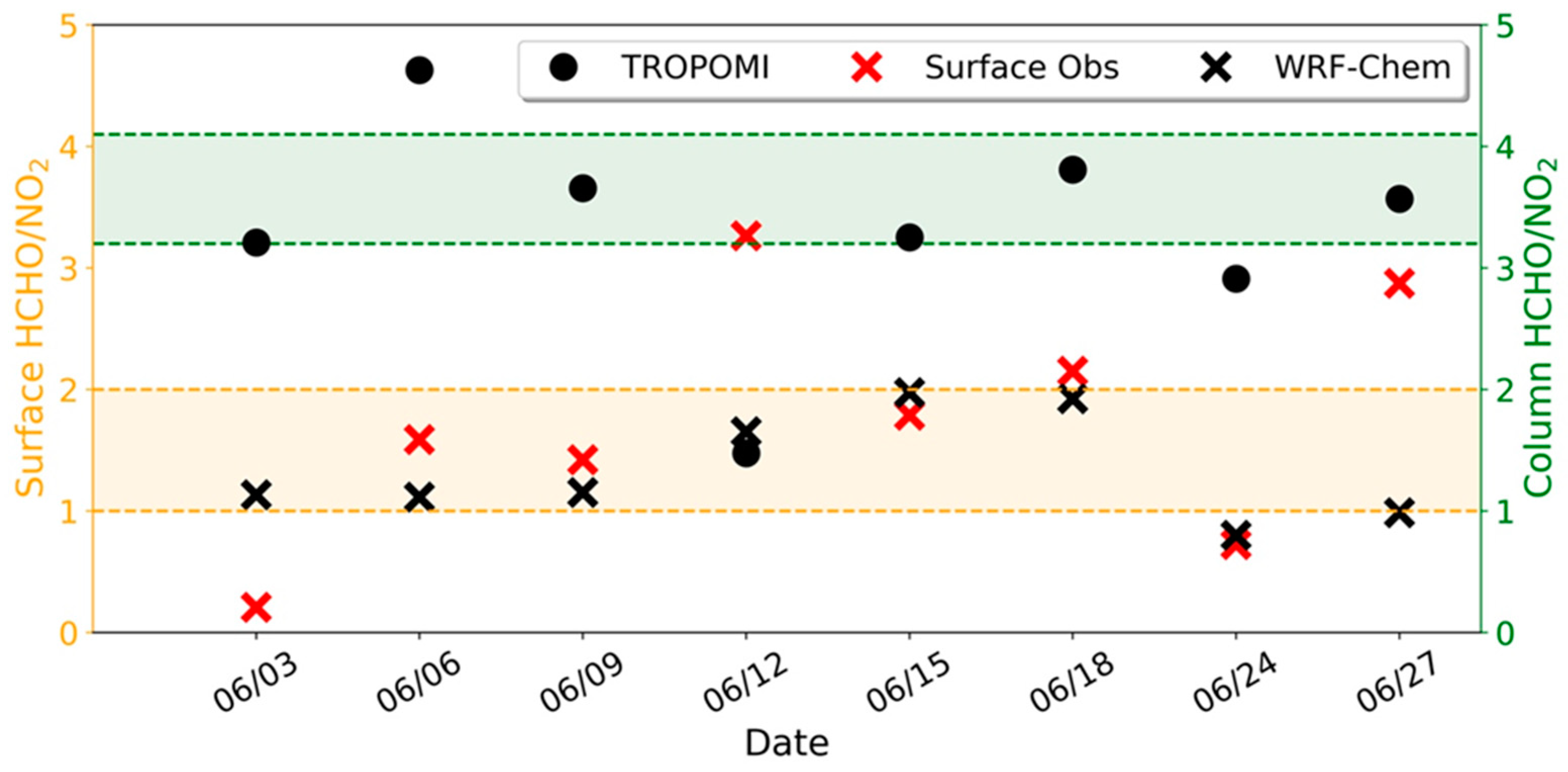Evaluating Phoenix Metropolitan Area Ozone Behavior Using Ground-Based Sampling, Modeling, and Satellite Retrievals
Abstract
:1. Introduction
2. Materials and Methods
2.1. LCS Data
2.2. Reference Monitor Data
2.3. VOC Data
2.4. Satellite Data
2.5. WRF-CHEM Modeling
3. Results and Discussion
3.1. Preliminary Site Classification
3.2. Effects of Wildfire Smoke on O3 Exceedances
3.3. Ozone Production Sensitivity from HCHO/NO2
3.3.1. Ground Sampling
3.3.2. Satellite Data
3.3.3. WRF-CHEM Modeling
3.3.4. Intercomparison
4. Conclusions
Supplementary Materials
Author Contributions
Funding
Institutional Review Board Statement
Informed Consent Statement
Data Availability Statement
Acknowledgments
Conflicts of Interest
References
- Maricopa County Air Quality Department. 2022 Air Monitoring Network Plan. 2022. Available online: https://www.maricopa.gov/DocumentCenter/View/76136/2022-Air-Monitoring-Network-Plan_Final?bidId= (accessed on 4 April 2024).
- U.S. Environmental Protection Agency; U.S. EPA. Integrated Science Assessment (ISA) for Ozone and Related Photochemical Oxidants. 2020. Available online: https://www.epa.gov/isa/integrated-science-assessment-isa-ozone-and-related-photochemical-oxidants (accessed on 4 April 2024).
- Crutzen, P.J. The influence of nitrogen oxides on the atmospheric ozone content. Q. J. R. Meteorol. Soc. 1970, 96, 320–325. [Google Scholar] [CrossRef]
- Chameides, W.L. The photochemical role of tropospheric nitrogen oxides. Geophys. Res. Lett. 1978, 5, 17–20. [Google Scholar] [CrossRef]
- National Research Council. Rethinking the Ozone Problem in Urban and Regional Air Pollution; National Academy Press: Washington, DC, USA, 1991.
- Milford, J.B.; Gao, D.; Sillman, S.; Blossey, P.; Russell, A.G. Total reactive nitrogen (NOy) as an indicator of the sensitivity of ozone to reductions in hydrocarbon and NOx emissions. J. Geophys. Res. Atmos. 1994, 99, 3533–3542. [Google Scholar] [CrossRef]
- Ashok, A.; Barrett, S.R.H. Adjoint-based computation of U.S. nationwide ozone exposure isopleths. Atmos. Environ. 2016, 133, 68–80. [Google Scholar] [CrossRef]
- Qian, Y.; Henneman, L.R.F.; Mulholland, J.A.; Russell, A.G. Empirical Development of Ozone Isopleths: Applications to Los Angeles. Environ. Sci. Technol. Lett. 2019, 6, 294–299. [Google Scholar] [CrossRef]
- Liu, C.; Zhang, L.; Wen, Y.; Shi, K. Sensitivity analysis of O3 formation to its precursors-Multifractal approach. Atmos. Environ. 2021, 251, 118275. [Google Scholar] [CrossRef]
- Chang, C.-Y.; Faust, E.; Hou, X.; Lee, P.; Kim, H.C.; Hedquist, B.C.; Liao, K.-J. Investigating ambient ozone formation regimes in neighboring cities of shale plays in the Northeast United States using photochemical modeling and satellite retrievals. Atmos. Environ. 2016, 142, 152–170. [Google Scholar] [CrossRef]
- Park, S.-Y.; Park, C.; Yoo, J.-W.; Lee, S.-H.; Lee, H.W. Adjoint sensitivity of inland ozone to its precursors and meteorological and chemical influences. Atmos. Environ. 2018, 192, 104–115. [Google Scholar] [CrossRef]
- Wang, N.; Lyu, X.; Deng, X.; Huang, X.; Jiang, F.; Ding, A. Aggravating O3 pollution due to NOx emission control in Eastern China. Sci. Total Environ. 2019, 677, 732–744. [Google Scholar] [CrossRef]
- Oikonomakis, E.; Aksoyoglu, S.; Ciarelli, G.; Baltensperger, U.; Prévot, A.S.H. Low modeled ozone production suggests underestimation of precursor emissions (especially NOx) in Europe. Atmos. Chem. Phys. 2018, 18, 2175–2198. [Google Scholar] [CrossRef]
- Dunker, A.M.; Wilson, G.; Bates, J.T.; Yarwood, G. Chemical Sensitivity Analysis and Uncertainty Analysis of Ozone Production in the Comprehensive Air Quality Model with Extensions Applied to Eastern Texas. Environ. Sci. Technol. 2020, 54, 5391–5399. [Google Scholar] [CrossRef]
- Mar, K.A.; Ojha, N.; Pozzer, A.; Butler, T.M. Ozone air quality simulations with WRF-Chem (v3.5.1) over Europe: Model evaluation and chemical mechanism comparison. Geosci. Model Dev. 2016, 9, 3699–3728. [Google Scholar] [CrossRef]
- Pfister, G.; Wang, C.; Barth, M.; Flocke, F.; Vizuete, W.; Walters, S. Chemical Characteristics and Ozone Production in the Northern Colorado Front Range. J. Geophys. Res. Atmos. 2019, 124, 13397–13419. [Google Scholar] [CrossRef]
- Xu, J.; Tie, X.; Gao, W.; Lin, Y.; Fu, Q. Measurement and model analyses of the ozone variation during 2006 to 2015 and its response to emission change in megacity Shanghai, China. Atmos. Chem. Phys. 2019, 19, 9017–9035. [Google Scholar] [CrossRef]
- Thorp, T.; Arnold, S.R.; Pope, R.J.; Spracklen, D.V.; Conibear, L.; Knote, C.; Arshinov, M.; Belan, B.; Asmi, E.; Laurila, T.; et al. Late-spring and summertime tropospheric ozone and NO2 in western Siberia and the Russian Arctic: Regional model evaluation and sensitivities. Atmos. Chem. Phys. 2021, 21, 4677–4697. [Google Scholar] [CrossRef]
- Abdi-Oskouei, M.; Roozitalab, B.; Stanier, C.O.; Christiansen, M.; Pfister, G.; Pierce, R.B.; McDonald, B.C.; Adelman, Z.; Janseen, M.; Dickens, A.F.; et al. The Impact of Volatile Chemical Products, Other VOCs, and NOx on Peak Ozone in the Lake Michigan Region. J. Geophys. Res. Atmos. 2022, 127, e2022JD037042. [Google Scholar] [CrossRef]
- Honoré, C.; Vautard, R.; Beekmann, M. Low and high NOx chemical regimes in an urban environment. Environ. Model. Softw. 2000, 15, 559–564. [Google Scholar] [CrossRef]
- Menut, L.; Bessagnet, B.; Briant, R.; Cholakian, A.; Couvidat, F.; Mailler, S.; Pennel, R.; Siour, G.; Tuccella, P.; Turquety, S.; et al. The CHIMERE v2020r1 online chemistry-transport model. Geosci. Model Dev. 2021, 14, 6781–6811. [Google Scholar] [CrossRef]
- Jin, X.; Fiore, A.M.; Murray, L.T.; Valin, L.C.; Lamsal, L.N.; Duncan, B.N.; Boersma, F.; De Smedt, I.; Abad, G.G.; Chance, K.; et al. Evaluating a Space-Based Indicator of Surface Ozone-NOx-VOC Sensitivity Over Midlatitude Source Regions and Application to Decadal Trends. J. Geophys. Res. Atmos. 2017, 122, 10439–10461. [Google Scholar] [CrossRef]
- Moiseenko, K.B.; Shtabkin, Y.A.; Berezina, E.V.; Skorokhod, A.I. Regional Photochemical Surface-Ozone Sources in Europe and Western Siberia. Izvestiya Atmos. Ocean. Phys. 2018, 54, 545–557. [Google Scholar] [CrossRef]
- Wang, W.; Ronald Van Der, R.; Ding, J.; Van Weele, M.; Cheng, T. Spatial and temporal changes of the ozone sensitivity in China based on satellite and ground-based observations. Atmos. Chem. Phys. 2021, 21, 7253–7269. [Google Scholar] [CrossRef]
- Emmons, L.K.; Hess, P.G.; Lamarque, J.-F.; Pfister, G.G. Tagged ozone mechanism for MOZART-4, CAM-chem and other chemical transport models. Geosci. Model Dev. 2012, 5, 1531–1542. [Google Scholar] [CrossRef]
- Sillman, S. The use of NOy, H2O2, and HNO3 as indicators for ozone-NOx-hydrocarbon sensitivity in urban locations. J. Geophys. Res. 1995, 100, 14175–14188. [Google Scholar] [CrossRef]
- Martin, R.V.; Fiore, A.M.; Van Donkelaar, A. Space-based diagnosis of surface ozone sensitivity to anthropogenic emissions. Geophys. Res. Lett. 2004, 31, L06120. [Google Scholar] [CrossRef]
- Duncan, B.N.; Yoshida, Y.; Olson, J.R.; Sillman, S.; Martin, R.V.; Lamsal, L.; Hu, Y.; Pickering, K.E.; Retscher, C.; Allen, D.J.; et al. Application of OMI Observations to a Space-Based Indicator of NOx and VOC Controls on Surface Ozone Formation. Atmos. Environ. 2010, 44, 2213–2223. [Google Scholar] [CrossRef]
- Schroeder, J.R.; Crawford, J.H.; Fried, A.; Walega, J.; Weinheimer, A.; Wisthaler, A.; Müller, M.; Mikoviny, T.; Chen, G.; Shook, M.; et al. New insights into the column CH2O/NO2 ratio as an indicator of near-surface ozone sensitivity. J. Geophys. Res. Atmos. 2017, 122, 8885–8907. [Google Scholar] [CrossRef]
- Souri, A.H.; Nowlan, C.R.; Wolfe, G.M.; Lamsal, L.N.; Chan Miller, C.E.; Abad, G.G.; Janz, S.J.; Fried, A.; Blake, D.R.; Weinheimer, A.J.; et al. Revisiting the effectiveness of HCHO/NO2 ratios for inferring ozone sensitivity to its precursors using high resolution airborne remote sensing observations in a high ozone episode during the KORUS-AQ campaign. Atmos. Environ. 2020, 224, 117341. [Google Scholar] [CrossRef]
- Souri, A.H.; Johnson, M.S.; Wolfe, G.M.; Crawford, J.H.; Fried, A.; Wisthaler, A.; Brune, W.H.; Blake, D.R.; Weinheimer, A.J.; Verhoelst, T.; et al. Characterization of errors in satellite-based HCHO/NO2 tropospheric column ratios with respect to chemistry, column-to-PBL translation, spatial representation, and retrieval uncertainties. Atmos. Chem. Phys. 2023, 23, 1963–1986. [Google Scholar] [CrossRef]
- Jin, X.; Fiore, A.; Boersma, F.; De Smedt, I.; Valin, L. Inferring Changes in Summertime Surface Ozone-NOx-VOC Chemistry over U.S. Urban Areas from Two Decades of Satellite and Ground-Based Observations. Environ. Sci. Technol. 2020, 54, 6518–6529. [Google Scholar] [CrossRef]
- Acdan, J.; Vermeuel, M.; Bertram, T.H.; Pierce, R.B. Observation-Based Analyses of the Sensitivity of Ozone Formation in the Lake Michigan Region to NOx and VOC Emissions. University of Wisconsin-Madison, Space Science and Engineering Center. 2020. Available online: https://www.ladco.org/wp-content/uploads/Projects/Ozone/2020_WI-DNR_OBM_Analysis/Blanchard_Final-Report_Sep2020.pdf (accessed on 4 April 2024).
- Müller, M.; Anderson, B.E.; Beyersdorf, A.J.; Crawford, J.H.; Diskin, G.S.; Eichler, P.; Fried, A.; Keutsch, F.N.; Mikoviny, T.; Thornhill, K.L.; et al. In situ measurements and modeling of reactive trace gases in a small biomass burning plume. Atmos. Chem. Phys. 2016, 16, 3813–3824. [Google Scholar] [CrossRef]
- Robinson, M.A.; Decker, Z.C.J.; Barsanti, K.C.; Coggon, M.M.; Flocke, F.M.; Franchin, A.; Fredrickson, C.D.; Gilman, J.B.; Gkatzelis, G.I.; Holmes, C.D.; et al. Variability and Time of Day Dependence of Ozone Photochemistry in Western Wildfire Plumes. Environ. Sci. Technol. 2021, 55, 10280–10290. [Google Scholar] [CrossRef] [PubMed]
- Wolfe, G.M.; Hanisco, T.F.; Arkinson, H.L.; Blake, D.R.; Wisthaler, A.; Mikoviny, T.; Ryerson, T.B.; Pollack, I.; Peischl, J.; Wennberg, P.O.; et al. Photochemical Evolution of the 2013 California Rim Fire: Synergistic Impacts of Reactive Hydrocarbons and Enhanced Oxidants. Atmos. Chem. Phys. 2022, 22, 4253–4275. [Google Scholar] [CrossRef]
- Andreae, M.O. Emission of trace gases and aerosols from biomass burning—An updated assessment. Atmos. Chem. Phys. 2019, 19, 8523–8546. [Google Scholar] [CrossRef]
- Jaffe, D.; Chand, D.; Hafner, W.; Westerling, A.; Spracklen, D. Influence of Fires on O3 Concentrations in the Western U.S. Environ. Sci. Technol. 2008, 42, 5885–5891. [Google Scholar] [CrossRef] [PubMed]
- Jaffe, D.; Wigder, N.; Downey, N.; Pfister, G.; Boynard, A.; Reid, S.B. Impact of Wildfires on Ozone Exceptional Events in the Western U.S. Environ. Sci. Technol. 2013, 47, 11065–11072. [Google Scholar] [CrossRef] [PubMed]
- Miech, J.A.; Stanton, L.; Gao, M.; Micalizzi, P.; Uebelherr, J.; Herckes, P.; Fraser, M.P. Calibration of low-cost NO2 sensors through environmental factor correction. Toxics 2021, 9, 281. [Google Scholar] [CrossRef] [PubMed]
- Miech, J.A.; Stanton, L.; Gao, M.; Micalizzi, P.; Uebelherr, J.; Herckes, P.; Fraser, M.P. In situ drift correction for a low-cost NO2 sensor network. Environ. Sci. Atmos. 2023, 3, 894–904. [Google Scholar] [CrossRef]
- Clarity. Clarity Node-S Technical Specifications V5. Available online: https://click.clarity.io/hubfs/Marketing%20Assets%20-%20PDFs/Product%20and%20Specification%20Sheets/Node-S%20Specifications%20Sheet.pdf?_ga=2.265223695.1874688595.1714159474-1436656120.1713376847&_gac=1.88362601.1713376850.CjwKCAjw5v2wBhBrEiwAXDDoJTPaOwAqRys1cwkPsu9vlR2-z-BFJl01w68iI0epak4QuB_QRtE7YBoC5gIQAvD_BwE (accessed on 31 January 2024).
- Copernicus Sentinel Data Processed by ESA, German Aerospace Center (DLR). 2020. Sentinel-5P TROPOMI Tropospheric Formaldehyde HCHO 1-Orbit L2 5.5 km × 3.5 km, Greenbelt, MD, USA, Goddard Earth Sciences Data and Information Services Center (GES DISC). Available online: https://sentinels.copernicus.eu/web/sentinel/data-products/-/asset_publisher/fp37fc19FN8F/content/sentinel-5-precursor-level-2-formaldehyde (accessed on 15 April 2023).
- Copernicus Sentinel Data Processed by ESA, Koninklijk Nederlands Meteorologisch Instituut (KNMI). 2021. Sentinel-5P TROPOMI Tropospheric NO2 1-Orbit L2 5.5 km × 3.5 km, Greenbelt, MD, USA, Goddard Earth Sciences Data and Information Services Center (GES DI). Available online: https://sentinels.copernicus.eu/web/sentinel/data-products/-/asset_publisher/fp37fc19FN8F/content/sentinel-5-precursor-level-2-nitrogen-dioxide (accessed on 15 April 2023).
- Ludewig, A.; Kleipool, Q.; Bartstra, R.; Landzaat, R.; Leloux, J.; Loots, E.; Meijering, P.; Van Der Plas, E.; Rozemeijer, N.; Vonk, F.; et al. In-flight calibration results of the TROPOMI payload on board the Sentinel-5 Precursor satellite. Atmos. Meas. Tech. 2020, 13, 3561–3580. [Google Scholar] [CrossRef]
- Van Geffen, J.; Boersma, K.F.; Eskes, H.; Sneep, M.; ter Linden, M.; Zara, M.; Veefkind, J.P. S5P TROPOMI NO2 slant column retrieval: Method, stability, uncertainties and comparisons with OMI. Atmos. Meas. Tech. 2020, 13, 1315–1335. [Google Scholar] [CrossRef]
- De Smedt, I.; Romahn, F.; Eichmann, K.-U.U. S5P Mission Performance Centre Formaldehyde [L2_HCHO__] Readme. 2023. Available online: https://sentinels.copernicus.eu/documents/247904/3541451/Sentinel-5P-Formaldehyde-Readme.pdf (accessed on 15 April 2023).
- Eskes, H.J.; Eichmann, K.-U.U. S5P Mission Performance Centre Nitrogen Dioxide [L2__NO2___] Readme. 2023. Available online: https://sentinel.esa.int/documents/247904/3541451/Sentinel-5P-Nitrogen-Dioxide-Level-2-Product-Readme-File.pdf (accessed on 15 April 2023).
- Grell, G.A.; Peckham, S.E.; Schmitz, R.; McKeen, S.A.; Frost, G.; Skamarock, W.C.; Eder, B. Fully coupled “online” chemistry within the WRF model. Atmos. Environ. 2005, 39, 6957–6975. [Google Scholar] [CrossRef]
- Emmons, L.K.; Walters, S.; Hess, P.G.; Lamarque, J.-F.; Pfister, G.G.; Fillmore, D.; Granier, C.; Guenther, A.; Kinnison, D.; Laepple, T.; et al. Description and evaluation of the Model for Ozone and Related chemical Tracers, version 4 (MOZART-4). Geosci. Model Dev. 2010, 3, 43–67. [Google Scholar] [CrossRef]
- Chin, M.; Ginoux, P.; Kinne, S.; Torres, O.; Holben, B.N.; Duncan, B.N.; Martin, R.V.; Logan, J.A.; Higurashi, A.; Nakajima, T. Tropospheric aerosol optical thickness from the GOCART model and comparisons with satellite and sun photometer measurements. J. Atmos. Sci. 2002, 59, 461–483. [Google Scholar] [CrossRef]
- Lamarque, J.-F.; Emmons, L.K.; Hess, P.G.; Kinnison, D.E.; Tilmes, S.; Vitt, F.; Heald, C.L.; Holland, E.A.; Lauritzen, P.H.; Neu, J.; et al. CAM-chem: Description and evaluation of interactive atmospheric chemistry in the Community Earth System Model. Geosci. Model Dev. 2012, 5, 369–411. [Google Scholar] [CrossRef]
- Tilmes, S.; Lamarque, J.-F.; Emmons, L.K.; Kinnison, D.E.; Ma, P.-L.; Liu, X.; Ghan, S.; Bardeen, C.; Arnold, S.; Deeter, M.; et al. Description and evaluation of tropospheric chemistry and aerosols in the Community Earth System Model (CESM1.2). Geosci. Model Dev. 2015, 8, 1395–1426. [Google Scholar] [CrossRef]
- Guenther, A.; Karl, T.; Harley, P.; Wiedinmyer, C.; Palmer, P.I.; Geron, C. Estimates of global terrestrial isoprene emissions using MEGAN (Model of Emissions of Gases and Aerosols from Nature). Atmos. Chem. Phys. 2006, 6, 3181–3210, Erratum in Atmos. Chem. Phys. 2007, 7, 4327. [Google Scholar] [CrossRef]
- Oleson, K.W.; Lawrence, D.M.; Bonan, G.B.; Flanner, M.G.; Kluzek, E.; Lawrence, P.J.; Levis, S.; Swenson, S.C.; Thornton, P.E.; Zeng, X. Technical Description of Version 4.0 of the Community Land Model (CLM) (No. NCAR/TN-478+STR); University Corporation for Atmospheric Research: Boulder, CO, USA, 2010. [Google Scholar] [CrossRef]
- Morrison, H.; Thompson, G.; Tatarskii, V. Impact of cloud microphysics on the development of trailing stratiform precipitation in a simulated squall line: Comparison of one- and two-moment schemes. Mon. Weather Rev. 2009, 137, 991–1007. [Google Scholar] [CrossRef]
- Iacono, M.J.; Delamere, J.S.; Mlawer, E.J.; Shephard, M.W.; Clough, S.A.; Collins, W.D. Radiative forcing by long-lived greenhouse gases: Calculations with the AER radiative transfer models. J. Geophys. Res. 2008, 113, D13103. [Google Scholar] [CrossRef]
- Monin, A.S.; Obukhov, A.M. Basic laws of turbulent mixing in the surface layer of the atmosphere. Contrib. Geophys. Inst. Acad. Sci. USSR 1954, 151, e187. [Google Scholar]
- Tewari, M.; Chen, F.; Wang, W.; Dudhia, J.; LeMone, M.A.; Mitchell, K.; Ek, M.; Gayno, G.; Wegiel, J.; Cuenca, R.H. Implementation and verification of the unified noah land surface model in the WRF model. Bull. Am. Meteorol. Soc. 2004, 14, 2165–2170. [Google Scholar]
- Hong, S. A new stable boundary-layer mixing scheme and its impact on the simulated East Asian summer monsoon. Q. J. R. Meteorol. Soc. 2010, 136, 1481–1496. [Google Scholar] [CrossRef]
- Grell, G.A.; Freitas, S.R. A scale and aerosol aware stochastic convective parameterization for weather and air quality modeling. Atmos. Chem. Phys. 2014, 14, 5233–5250. [Google Scholar] [CrossRef]
- Seinfeld, J.H.; Pandis, S.N. Atmospheric Chemistry and Physics: From Air Pollution to Climate Change, 2nd ed.; Wiley: Hoboken, NJ, USA, 2006. [Google Scholar]
- Guo, Y.; Roychoudhury, C.; Mirrezaei, M.A.; Kumar, R.; Sorooshian, A.; Arellano, A.F. Investigating Ground-Level Ozone Pollution in Semi-Arid and Arid Regions of Arizona Using WRF-Chem v4. 4 Modeling. Geosci. Model Dev. Discuss. 2024; preprint. [Google Scholar] [CrossRef]
- Finlayson-Pitts, B.J.; Pitts, J.N. Chemistry of the Upper and Lower Atmosphere: Theory, Experiments and Application, 1st ed.; Academic Press: Cambridge, MA, USA, 2000. [Google Scholar]
- McKenzie, R.; Johnston, P.; Hofzumahaus, A.; Kraus, A.; Madronich, S.; Cantrell, C.; Calvert, J.; Shetter, R. Relationship between photolysis frequencies derived from spectroscopic measurements of actinic fluxes and irradiances during the IPMMI campaign. J. Geophys. Res. Atmos. 2002, 107, ACH-1. [Google Scholar] [CrossRef]
- Parrish, D.D.; Murphy, P.C.; Albritton, D.L.; Fehsenfeld, F.C. The measurement of the photodissociation rate of NO2 in the atmosphere. Atmos. Environ. (1967) 1983, 17, 1365. [Google Scholar] [CrossRef]
- Barnard, J.C.; Chapman, E.G.; Fast, J.D.; Schmelzer, J.R.; Slusser, J.R.; Shetter, R.E. An evaluation of the FAST-J photolysis algorithm for predicting nitrogen dioxide photolysis rates under clear and cloudy sky conditions. Atmos. Environ. 2004, 38, 3393. [Google Scholar] [CrossRef]














Disclaimer/Publisher’s Note: The statements, opinions and data contained in all publications are solely those of the individual author(s) and contributor(s) and not of MDPI and/or the editor(s). MDPI and/or the editor(s) disclaim responsibility for any injury to people or property resulting from any ideas, methods, instructions or products referred to in the content. |
© 2024 by the authors. Licensee MDPI, Basel, Switzerland. This article is an open access article distributed under the terms and conditions of the Creative Commons Attribution (CC BY) license (https://creativecommons.org/licenses/by/4.0/).
Share and Cite
Miech, J.A.; Herckes, P.; Fraser, M.P.; Arellano, A.F.; Mirrezaei, M.A.; Guo, Y. Evaluating Phoenix Metropolitan Area Ozone Behavior Using Ground-Based Sampling, Modeling, and Satellite Retrievals. Atmosphere 2024, 15, 555. https://doi.org/10.3390/atmos15050555
Miech JA, Herckes P, Fraser MP, Arellano AF, Mirrezaei MA, Guo Y. Evaluating Phoenix Metropolitan Area Ozone Behavior Using Ground-Based Sampling, Modeling, and Satellite Retrievals. Atmosphere. 2024; 15(5):555. https://doi.org/10.3390/atmos15050555
Chicago/Turabian StyleMiech, Jason A., Pierre Herckes, Matthew P. Fraser, Avelino F. Arellano, Mohammad Amin Mirrezaei, and Yafang Guo. 2024. "Evaluating Phoenix Metropolitan Area Ozone Behavior Using Ground-Based Sampling, Modeling, and Satellite Retrievals" Atmosphere 15, no. 5: 555. https://doi.org/10.3390/atmos15050555
APA StyleMiech, J. A., Herckes, P., Fraser, M. P., Arellano, A. F., Mirrezaei, M. A., & Guo, Y. (2024). Evaluating Phoenix Metropolitan Area Ozone Behavior Using Ground-Based Sampling, Modeling, and Satellite Retrievals. Atmosphere, 15(5), 555. https://doi.org/10.3390/atmos15050555







